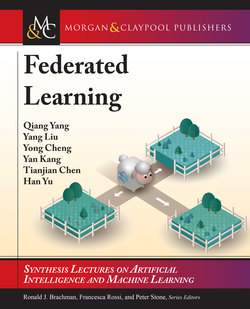Читать книгу Federated Learning - Yang Liu - Страница 12
На сайте Литреса книга снята с продажи.
ОглавлениеCHAPTER 3
Distributed Machine Learning
As we know from Chapter 1, federated learning and distributed machine learning (DML) share several common features, e.g., both employing decentralized datasets and distributed training. Federated learning is even regarded as a special type of DML by some researchers, see, e.g., Phong and Phuong [2019], Yu et al. [2018], Konecný et al. [2016b] and Li et al. [2019], or seen as the future and the next step of DML. In order to gain deeper insights into federated learning, in this chapter, we provide an overview of DML, covering both the scalability-motivated and the privacy-motivated paradigms.
DML covers many aspects, including distributed storage of training data, distributed operation of computing tasks, and distributed serving of model results, etc. There exist a large volume of survey papers, books, and book chapters on DML, such as Feunteun [2019], Ben-Nun and Hoefler [2018], Galakatos et al. [2018], Bekkerman et al. [2012], Liu et al. [2018], and Chen et al. [2017]. Hence, we do not intend to provide another comprehensive survey on this topic. We focus here on the aspects of DML that are most relevant to federated learning, and refer the readers to the references for more details.
3.1 INTRODUCTION TO DML
3.1.1 THE DEFINITION OF DML
DML, also known as distributed learning, refers to multi-node machine learning (ML) or deep learning (DL) algorithms and systems that are designed to improve performance, preserve privacy, and scale to more training data and bigger models [Trask, 2019, Liu et al., 2017, Galakatos et al., 2018]. For example, as illustrated in Figure 3.1, a DML system with three workers (a.k.a. computing nodes) and one parameter server [Li et al., 2014], the training data are split into disjoint data shards and sent to the workers, and the workers carry out stochastic gradient descent (SGD) at their locality. The workers send gradients Δwi or model weights wi to the parameter server, where the gradients or model weights are aggregated (e.g., via taking weighted average) to obtain the global gradients Δw or model weights w. Both synchronous and asynchronous SGD algorithms can be applied in DML [Ben-Nun and Hoefler, 2018, Chen et al., 2017].
